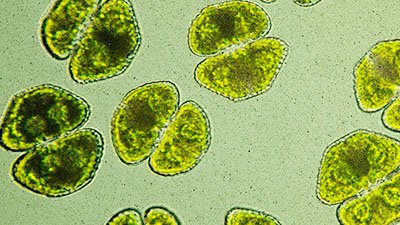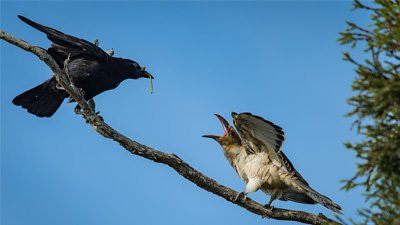The Origin of Sexual and Asexual Reproduction
Life cycles are an interesting thing to study. Organisms are born and produce offspring in so many ways. These differences produce a great deal of variation in what we observe in the world. They also provide a significant challenge to any model of origins that rejects the biblical account, including evolution.
Reproduction is broadly delineated into two major groupings: sexual and asexual. Sexual reproduction requires two organisms to exchange genetic material in cells contained in gametes. Asexual reproduction requires only one organism. Some organisms can reproduce both ways, while others are restricted to just one mechanism of reproduction.
Asexual Reproduction
Asexual reproduction is the primary mechanism of reproduction for the vast majority of organisms on the planet.
Asexual reproduction is the primary mechanism of reproduction for the vast majority of organisms on the planet; however, there are multiple ways that asexual reproduction occurs. Some organisms can reproduce using several of these methods.
Cloning is perhaps the most well-known mechanism of asexual reproduction, in part due to its appearance in multiple sci-fi series. However absurdly it is portrayed in sci-fi, cloning does occur in some asexual organisms and even in the larva of some sexual organisms.1 What cloning does is completely duplicate the genome of an organism into its offspring. Thus, when cloning occurs, the offspring are all exact copies of the adult, with few genetic differences.
Binary fission is yet another mechanism of asexual reproduction, which is regarded as a form of cloning. This method of reproduction is mostly restricted to prokaryotes, organisms that lack a defined nucleus. Essentially, in binary fission, the organism makes a complete copy of itself, then splits in half. Binary fission is only possible in very small organisms, such as prokaryotic mycoplasmas.2
While not quite the same as cloning, parthenogenesis is another method of asexual reproduction that periodically occurs in some sexually reproducing organisms. In this mode of reproduction, the organism reproduces alone, giving rise to one or more clones of itself, without the need to mate. This has been observed in numerous vertebrates,3 and is believed to be the source of the infamous marbled crayfish.4
A third method of asexual reproduction is called budding. Budding takes place when an adult organism produces a clone of itself that “buds” off the side of the adult organism. Some organisms will undergo budding as well as normal sexual reproduction, such as hydras.5 Other organisms, like yeasts, rely almost exclusively on budding.6
Another method of asexual reproduction is fragmentation. In fragmentation, the organism splits itself, or is split by an outside force, into multiple parts, all of which then regrow the remainder of the body. This could be considered a strange method of cloning as it does produce identical clones of the parent organism. The most well documented examples among animals come from starfish, which are famous for being able to be chopped into pieces and regrow whole organisms from a single arm and a piece of the central disk. However, other organisms do this as well. Some worms also reproduce by fragmentation.7
Vegetative propagation is a well-known method of reproduction, particularly in plants. It involves a part of the plant branching off from the rest of the plant and eventually growing into an entirely new plant. In some cases, the two plants remain attached and form long chains of connected plants, each with all the properties of an individual plant but connected in some way either above or below ground. Mosses are known to undergo this process.8 Numerous plants, as well as some algae, also undergo vegetative reproduction in one form or another.9 The most common forms of this are frequently used in gardening, as cuttings; pieces broken or cut from a plant which grow into a new plant.
Spore production is another mechanism of asexual reproduction. Spores may be thought of as essentially “seeds” that are produced asexually and designed to be spread through a wide area. Spores are the choice method of reproduction of many fungi,10 but some plants, particularly ferns and mosses, also use this method of reproduction.
Sexual Reproduction
Sexually reproducing organisms are less prone to populations crashing and going extinct due to the buildup of negative mutations, as mutations are diluted within the population.
Unlike asexual reproduction, sexual reproduction requires two individuals to exchange genetic material in order to produce offspring. There are significantly fewer methods of sexual reproduction. Of note, sexually reproducing organisms are less prone to populations crashing and going extinct due to the buildup of negative mutations, as mutations are diluted within the population. Unlike asexual reproduction, sexual reproduction involves the formation of special reproductive cells called gametes. These gametes are exchanged in one of a number of ways, primarily categorized as internal and external fertilization. In all cases, male-produced gametes, called sperm, fertilize female-produced gametes, called eggs (or ova), leading to the production of offspring with combined genetic material from each parent.
The first and perhaps most common mechanism of sexual reproduction in animals is oviparity where the young are hatched from eggs. Both parents release gametes and the eggs are either deliberately fertilized or accidentally fertilized during what is called broadcast spawning. Other organisms lay eggs on a surface, which are then fertilized. In some larger, more mobile animals, fertilization is internal, and the eggs are then laid and hatch outside the mother’s body. Everything from invertebrates to amphibians, birds, and reptiles undergo oviparous reproduction.11
Ovoviviparous organisms are also well known. These organisms hatch from eggs, like oviparous organisms, but these eggs are not fertilized externally. Instead, during mating, male gametes are passed to the female and fertilize her eggs inside her body. The eggs hatch inside the mother’s body or immediately after birth and are, thus, born alive. Many insects and fish exhibit this type of reproduction but other organisms, such as snails and snakes, do as well.12
Viviparity is the third type of sexual reproduction that animals use. Viviparity involves internal fertilization and live birth of the organism in question, without growing from within a shelled egg. This is the type of reproduction associated mainly with mammals (except for monotremes), but also some fish, reptiles, and other animals.13 They do not hatch from eggs before birth, unlike in ovoviviparous organisms, because once the egg fuses with the sperm, the embryo develops in the absence of an external shell and gets nutrients directly from the mother’s body rather than a yolk sac.
In plants, sexual reproduction occurs through the well-known mechanism of pollination. This mechanism involves the production of male and female gametes, usually on the same plant, though sometimes on different plants. Male gametes are called pollen and contain the sperm, hence the term pollination. Pollen is transferred from one plant to another through a number of different methods, from the well-known example of honeybees to the wind simply carrying it from one plant to another. The pollen settles on the female reproductive part (the pistil), where the sperm is transferred to fertilize the eggs, which then develop into seeds.
Origins of Reproduction
Reproduction is a significant puzzle for evolutionists. On the one hand, their dogma requires reproduction, and lots of it, to produce the variation we observe in the modern world. On the other, reproduction is complex and difficult to explain from an evolutionary worldview. There are a lot of questions scientists simply struggle to even understand, let alone give the answers to. One such example surfaced in recent literature when evolutionists were stunned to discover a stickleback fish that was undergoing parthenogenesis and carrying unfertilized eggs. Since sticklebacks usually lay eggs and fertilize them externally, this was surprising. Even more surprising, the eggs were viable and hatched.14
In order for evolution to work, reproduction needs to happen quickly and efficiently.
In order for evolution to work, reproduction needs to happen quickly and efficiently. After all, according to self-proclaimed science authority Bill Nye, “For me, the meaning of life is pretty clear: Living things strive to pass their genes into the future.”15 UC Berkeley’s website attempts to clarify misconceptions about evolution and indirectly confirms this by pointing out that, evolutionarily, fitness is dependent on an organism’s ability to pass on its genes, not its ability to survive.16 Therefore, it is critical that reproduction occur as frequently as possible in order to ensure evolutionary success.
Based on this, asexual reproduction would appear to be the way to go. It is much more efficient and only requires one organism. Further, often the time it takes to reproduce asexually is much less than the time it takes to reproduce sexually. This being the case, it is logical to question why sexual reproduction exists in an evolutionary paradigm.
To be fair, evolutionists have recognized this problem and postulated a number of explanations. One study suggested that sex evolved so that species can exist and diversify into new species.17 This, however, is not a mechanism to explain the origin of sexual reproduction. An older paper argues that sexual reproduction arose from the need to deal with damage to the genome.18 While sexual reproduction does help mask mutational damage to the genome, this argument is trying to have it both ways. Either evolution is a blind purposeless process with no end in mind, in which case it will not “need” to fix the genome, or, if evolution can recognize “needs” and respond to them, it becomes intelligently guided, forcing the evolutionists to recognize it is not a purely natural process. They cannot have both a blind purposeless process and one that recognizes needs. And any intermediary organism, having a “half-sexual” reproductive system, would be even less fit to pass on its genes.
Other evolutionists have opted for a different mechanism, claiming that sexual reproduction evolved as a response to asexual organisms being heavily attacked by parasites.19 The idea behind this parasitic resistance is that sexual reproduction scrambles the information in a population’s genome in each generation. This makes it harder for parasites to invade their hosts by changing up the structure and function of the host slightly, leaving parasites with a less reliable path to survival. This argument has multiple issues, including lacking a mechanism. For this to work, the host would need to undergo radical genetic changes to produce radically different physical structures. Barring this, the host can only make small changes. This being the case, this argument must assume that parasites are not able to adapt to small changes in the host, which is spurious. Further, it would require a significant change in the DNA to go from asexual to sexual, which is a common theme across all these proposals. Even worse, it does nothing to explain why there are still asexual organisms. Another argument proposed by some is that sexual reproduction was necessary to slow down evolution, thereby limiting the change that occurs—the exact opposite of the claim that sexual reproduction increases diversity that was mentioned previously!20 Clearly, naturalists must struggle to even explain why sexual reproduction exists, let alone how it developed in an evolutionary paradigm.
Interestingly, asexual reproduction, which seems to make slightly more sense in an evolutionary paradigm, provides similar problems. One study admits in the opening sentences of the paper that asexual organisms are supposed to be on the swift path to extinction, yet purportedly ancient lineages of asexual organisms are still with us.21 Another study confirmed this problem and, to make matters worse, pointed out that empirical evidence for any theory of the origins of sexual reproduction is sorely lacking.22 Asexual reproduction is just as troublesome as sexual reproduction to evolutionary theorists.
Evolutionists recognize they have a problem. One evolutionist wrote, “Sex is the queen of problems in evolutionary biology.”23 More recently, influential evolutionist Richard Dawkins wrote, “To say, as I have, that good genes can benefit from the existence of sex whereas bad genes can benefit from its absence, is not the same thing as explaining why sex is there at all. There are many theories of why sex exists, and none of them is knock-down convincing.”24 Dawkins goes on to briefly discuss one of the options, of which there are many, before completely leaving the topic alone. Evolutionists are seemingly baffled by the arrival of sexual and asexual reproduction, and sexual reproduction in particular.
A Biblical Perspective
When we change from the evolutionary glasses to biblical glasses, however, things become clear. The Bible tells us that humans were made in the beginning as male and female (Genesis 1:26–27; Mark 10:6). Further, Genesis 1 tells us that the plants and animals were to reproduce according to their kinds (Genesis 1:11–12, 20–25). There is no reason to believe both sexual and asexual lineages were not created in those verses, placing the origin of all modes of reproduction at the very beginning of the creation.
This biblical perspective completely removes the problem of the origins of reproduction.
This biblical perspective completely removes the problem of the origins of reproduction. Variety and reproduction was part of God’s original intention for microorganisms, plants, animals, and man. As such, it was built into the creation from the beginning, and we are just now beginning to understand it and appreciate the variety, complexity, and provisional nature of God’s handiwork.
Conclusion
Evolutionists are completely unable to explain the origin of sexual reproduction—or any type of reproduction for that matter! They have produced a lot of contradictory hypotheses and often appeal to logical fallacies to make them work. Ultimately, none of them have any observable evidence to back them up. To make matters worse, asexual lineages should be going extinct in the evolutionary paradigm, yet there are thousands of obligate asexual kinds in the world, many of which are ancient by evolutionists’ own admission. The biblical perspective provides a much more satisfactory answer. God made both forms of reproduction in the beginning, commanding the animals and man to reproduce and fill the earth he had made.
Footnotes
- Alexandra A. Eaves and A. Richard Palmer, “Widespread Cloning in Echinoderm Larvae,” Nature 425 (2003): 146, http://www.biology.ualberta.ca/palmer.hp/pubs/03Nature/Eaves+03_Nature.pdf.
- Shmuel Razin and Leonard Hayflick, “Highlights of Mycoplasma Research–An Historical Perspective,” Biologicals (2010): 1–8, doi:10.1016/j.biologicals.2009.11.008.
- Warren Booth et al., “Facultative Parthenogenesis Discovered in Wild Vertebrates,” Biology Letters 8, no. 6. (2012): doi:10.1098/rsbl.2012.0666.
- Peer Martin et al., “The Enigmatic Marmokrebs (Marbled Crayfish) Is the Pathenogenetic Form of Procambarus fallax (Hagen, 1870),” Contributions to Zoology 79, no. 3 (2010): 107–118, doi:10.1163/18759866-07903003.
- Anita Kaliszewicz “Interference of Asexual and Sexual Reproduction in the Green Hydra,” Ecological Research 26 (2011): 147–152, doi:10.1007/s11284-010-0771-6.
- Gianni Liti, “The Fascinating and Secret Wild Life of the Budding Yeast S. cerevisiae,” eLife (2015): doi:10.7554/eLife.05835.
- Norio Miyamoto and Yansunori Saito, “Morphological Characterization of the Asexual Reproduction in the Acorn Worm Balanoglossus simodensis,” Development, Growth, and Differentiation 52 (2010): 615–627, doi:10.1111/j.1440-169X.2010.01197.x.
- Vincent Hugonnot and Jaoua Celle, “Asexual Reproduction by Leaf Fragmentation in Mnium stellare Hedw,” Journal of Bryology 34, no. 1 (2012): 67–69, doi:10.1179/1743282011Y.0000000036.
- Christopher A. Proctor, Roch E. Gaussoin, and Zachary J. Reicher, “Vegetative Reproduction Potential of the Common Purslane. (Portulaca oleracea),” Weed Technology 25 (2011): 694–697, doi:10.1614/WT-D-11-00045.1; and Ester Cecere, Antonella Petrocelli, and Marc Verlaque, “Vegetative Reproduction by Multicellular Propagules in Rhodophyta: An Overview,” Marine Ecology (2011): 1–19, doi:10.1111/j.1439-0485.2011.00448.x.
- Julie Mrleau et al., “Spore Development and Nuclear Inheritance in Arbuscular Mycorrhizal Fungi,” BMC Evolutionary Biology 11, no. 51 (2011): doi:10.1186/1471-2148-11-51.
- Anna Sulikoska-Drozd and Tomas K. Maltz, “Oviparous Reproduction of Vestia ranojevici moravica Confirms Taxonomic Value of Life History Characters in Carpathian Clausiliids (Gastropoda: Pulmonata),” Biologia 68, no. 4 (2013): 687–695, doi:10.2478/s11756-013-0209-z; and Fausto R. Mendez-de la Cruz et al., “Reproductive Cycle of a High-Elevation Oviparous Lizard (Sceloporus spinosus: Reptilia:Phrynosomatidae),” The Southwestern Naturalist 58, no. 1 (2013): 54–63, doi:10.1894/0038-4909-58.1.54.
- Krystyna Szybiak and Elzbieta Gabala, “Anatomical and Histological Structure of the Spermoviduct in the Ovoviviparous Snail Ruthenica filograna (Pulmonata, Clausiliidae),” Invertebrate Reproduction and Development 57, no. 4 (2013): doi:10.1080/07924259.2012.761653.
- Jin-Xian Liu and John C. Avise, “High Degree of Multiple Paternity in the Viviparous Shiner Perch, Cymatogaster aggregate, a Fish with Long Term Female Sperm Storage,” Marine Biology 158, no.4 (2011): 893–901, doi:10.1007/s00227-010-1616-0.
- Laura L. Dean et al., “Internal Embryonic Development in a Non-Copulatory, Egg-Laying Teleost, the Three-Spined Stickleback, Gasterosteus aculeatus,” Scientific Reports 9 (2019): doi:10.1038/s41598-019-38584-w.
- Brad Kramer, “BioLogos Interviews Bill Nye,” BioLogos, February 4, 2015, https://biologos.org/articles/series/biologos-interviews-bill-nye/biologos-interviews-bill-nye.
- USC Berkeley, “Misconceptions About Evolution,” https://evolution.berkeley.edu/evolibrary/misconceptions_teacherfaq.php, accessed 03/08/2019.
- Ursula Goodenough and Joseph Heitman, “Origins of Eukaryotic Sexual Reproduction,” Cold Spring Harbor Perspectives in Biology (2014): https://cshperspectives.cshlp.org/content/6/3/a016154.full.pdf.
- Harris Bernstein et al., “Origin of Sex,” Journal of Theoretical Biology 110 (1984): 323–351, doi:10.1016/S0022-5193(84)80178-2.
- Carl Zimmer, “On the Origin of Sexual Reproduction,” Science 324, no. 5932 (2009): 1254–1256, doi:10.1126/science.324_1254.
- Root Gorelick and Henry H. Q. Heng, “Sex Reduces Genetic Variation: A Multidisciplinary Review,” Evolution 65, no. 4 (2010): 1088–1098, doi:10.1111/j.1558-5646.2010.01173.x.
- Benjamin B. Normark, Olivia P. Judson, and Nancy A. Moran, “Genomic Signatures of Ancient Asexual Lineages,” Biological Journal of the Linnean Society 79 (2003): 69–84, doi:10.1046/j.1095-8312.2003.00182.x.
- Maurine Neiman, Stephanie Meirmans, and Patrick G. Meirmans, “What Can Asexual Lineage Age Tell Us About the Maintenance of Sex?,” Annals of the New York Academy of Sciences (2009): 185–200, doi:10.1111/j.1749-6632.2009.04572.x.
- Graham Bell, The Masterpiece of Nature: The Evolution and Genetics of Sexuality (Berkeley: Univ. of California, 1982), 19.
- Richard Dawkins, Climbing Mount Improbable (New York: W. W. Norton & Company, 1996), 85.
Recommended Resources

Answers in Genesis is an apologetics ministry, dedicated to helping Christians defend their faith and proclaim the good news of Jesus Christ.
- Customer Service 800.778.3390
- © 2024 Answers in Genesis






